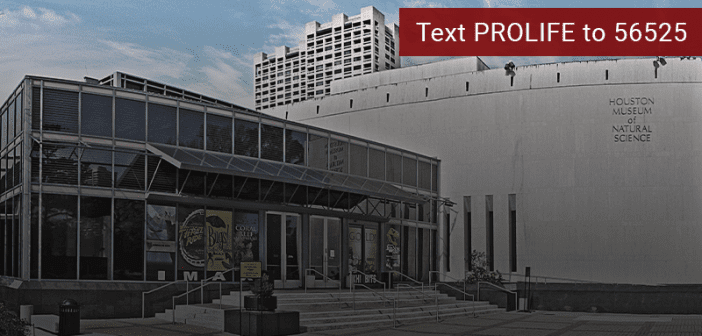Pro-Lifers have begun petitioning the Houston Museum of Natural Science to remove an exhibit featuring the bodies of preborn babies. The BODY WORLDS and the Life Cycle exhibit is marketed as a “breathtaking encounter with the inner workings of the human body.” The display is breathtaking insofar as the grotesque presentation of mangled human bodies, including the remains of preborn babies, shocks viewers.
The exhibition on the life cycle features more than 100 human bodies and pieces of bodies plastinated and posed on display. Houston Museum of Natural Science Curator of Anthropology Dr. Dirk VanTuerenhout claimed that all of the bodies were, “Real remains of fellow humans, all of whom donated their bodies during their lifetimes, are on display.” This claim is suspect, to say the least.
The displays using human bodies have caused controversy since their inception due to the unverified source of human remains used in the displays. Unlike similar exhibits, the current exhibit appears not to rely on sourcing cadavers from China. In the exhibits that used Chinese bodies “donated” for science, producers of the plastinated exhibits could not verify that the bodies were not of political prisoners subjected to torture.
The BODY WORLDS exhibit, produced by a company based in Germany, seems to verify that most donors are voluntary. According to the company’s website, “The Institute for Plastination in Heidelberg, Germany is the administrator of the body donation program for Plastination. It has a roster of 19,222 registered body donors (as of June 2019), the majority of the donors are German.” Likely due to the backlash received with similar displays, the current exhibition prominently displays information about the donation program.
Even here, the utilitarian approach to the human body is disturbing. The website states, “Many donors underscore that by donating their body, they want to be useful to others even after their death.” In these exhibits, which mangle the human body for public display, the flesh that once lived is treated as a useful specimen. The degradation of our culture is apparent when Life is not viewed as full worthy without being “useful to others.” The promotional material focuses on “science,” but the media coverage is more direct, calling the display “sliced-and-diced cadavers.”
The current exhibition in Houston raises particular concern because of the emphasis on “showcasing the wonders of human development.” A portion of the exhibit, titled “A Heartbreaking Work of Staggering Genius,” is described as “a stunning look at conception and prenatal development, which features a multimedia display on cell division and a remarkable collection of plastinates acquired from historical anatomical collections.” In this portion of the display, the bodies of preborn babies have been preserved through the same plastination process.
Although the producers of the exhibit stress donor consent so explicitly, they do not publicize the source of the preborn babies. The bodies of these children may have been obtained following miscarriage but there is grave concern that the “specimens” were collected through elective abortion.
Following these revelations, the advocacy organization Tradition Family Property started a petition asking the Houston Museum of Natural Science to remove the exhibit. Whether donors willingly gave their bodies to be “sliced-and-diced” and grotesquely displayed, the babies who died while still preborn had no means of giving consent to their exploitation. You can read more and sign the petition at the Tradition Family Property website.
There was rightly outrage and concern over the unverified origins of bodies previously on display in similar exhibits around the world. Many of the bodies acquired in China were suspected of being involuntarily obtained following imprisonment and torture. If the preborn babies featured in the most recent display were killed in elective abortion, theirs was an even more gruesome and painful death. The public deserves an answer about the source of these human remains and an explanation for their treatment.
Sadly, the profit motive does not align with transparency. The previous installments of BODY WORLDS exhibits at the Houston Museum of Natural Science in 2006 and 2008 were the most popular in the museum’s history, viewed by nearly 800,000 people in Houston and more than 50 million worldwide.

